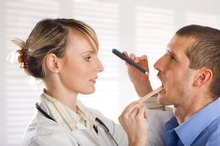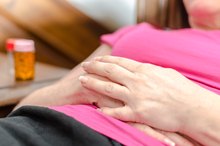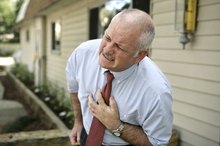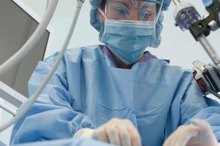What Causes Abdominal Pain With Palpation?
Many conditions can cause abdominal pain with palpation. The abdomen is a part of the body that is easily examined by palpation or touch. Certain abdominal conditions cause tenderness when a specific point in the abdomen or the entire abdomen is palpated 1. The location and intensity of the pain are clues that help physicians determine the cause of the pain and the appropriate course of treatment. Abdominal pain with palpation can be mild, moderate or severe.
If you are experiencing serious medical symptoms, seek emergency treatment immediately.
Appendicitis
Appendicitis causes severe abdominal pain when the right lower abdomen is palpated 2. According to MayoClinic.com, appendicitis is a condition in which a person's appendix becomes inflamed and fills with pus 2. The appendix is a short, narrow tube that projects out from the large intestine in the right lower abdominal quadrant. Although appendicitis can manifest in anyone, it commonly affects people between the ages of 10 and 30 2. In most cases, the appendix is removed before life-threatening complications can arise.
Hepatitis
What Causes Left Lower Abdominal Pain With Palpation?
Learn More
Hepatitis can cause abdominal pain when the liver is palpated or examined by hand. Hepatitis is inflammation of the liver. Hepatitis may be caused by viral infections, alcohol-related liver damage, certain medications and certain autoimmune conditions or conditions in which the body's immune system attacks its own tissues or organs. Certain risk factors may increase the likelihood of developing hepatitis, including intravenous drug use, consuming contaminated foods, alcohol abuse, having HIV or AIDS, being an organ transplant recipient or engaging in risky sexual behaviors.
- Hepatitis can cause abdominal pain when the liver is palpated or examined by hand.
- Certain risk factors may increase the likelihood of developing hepatitis, including intravenous drug use, consuming contaminated foods, alcohol abuse, having HIV or AIDS, being an organ transplant recipient or engaging in risky sexual behaviors.
Peritonitis
Peritonitis can cause intense abdominal pain when pressure is applied to the abdomen during abdominal palpation. Peritonitis is an inflammation of the peritoneum--a thin membrane that covers the abdominal wall and envelops the abdominal organs. According to the University of Maryland Medical Center, peritonitis can be caused by bacterial or fungal infections of the peritoneum 4.
Related Articles
References
- MedlinePlus: Point Tenderness--Abdomen
- MayoClinic.com: Appendicitis
- MedlinePlus: Hepatitis
- University of Maryland Medical Center: Peritonitis
- National Institute of Diabetes and Digestive and Kidney Diseases. Appendicitis. Updated November 2014.
- Simó Alari F, Gutierrez I, Gimenéz Pérez J. Familial history aggregation on acute appendicitis. BMJ Case Rep. 2017;2017. doi:10.1136/bcr-2016-218838
- Anshul F, Naids JM, Thakur K. Silent appendicitis in an immunocompromised patient: A diagnostic dilemma. Am J Gastroenterol. 2017;112:S1317-S1318. doi:10.14309/00000434-201710001-02417
- Wei CK, Chang CM, Lee CH, Chen JH, Yin WY. Acute appendicitis in organ transplantation patients: a report of two cases and a literature review. Ann Transplant. 2014;19:248-52. doi:10.12659/aot.890418
- Bach L, Donovan A, Loggins W, Thompson S, Richmond B. Appendicitis in diabetics: predictors of complications and their incidence. Am Surg. 2016;82(8):753-8.
- Forghieri F, Luppi M, Narni F, et al. Acute appendicitis in adult neutropenic patients with hematologic malignancies. Bone Marrow Transplant. 2008;42(10):701-3. doi:10.1038/bmt.2008.235
- Kutasy B, Puri P. Appendicitis in obese children. Pediatr Surg Int. 2013;29(6):537-44. doi:10.1007/s00383-013-3289-5
- Drake FT, Flum DR. Improvement in the diagnosis of appendicitis. Adv Surg. 2013;47:299-328.
Writer Bio
Martin Hughes is a chiropractic physician, health writer and the co-owner of a website devoted to natural footgear. He writes about health, fitness, diet and lifestyle. Hughes earned his Bachelor of Science in kinesiology at the University of Waterloo and his doctoral degree from Western States Chiropractic College in Portland, Ore.








